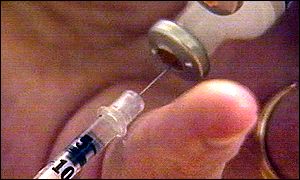
Some diabetics currently have to inject insulin |
See also: 27 Aug 01 Insulin pill hope for diabetics 31 Jul 01 Hormone boost could fight diabetes 03 Jan 01 Diabetes gene identified 13 Jul 00 'Holy grail' for diabetics draws closer 29 Feb 00 Diabetes reversed in the lab |
|
Internet links: American Vacuum Society Diabetes UK |
|
Top Health stories now: Transplant first for cancer patient Costly wait with dementia symptoms Chicken checked for BSE New hope for Aids vaccine Campaign to end stigma of mental illness Parents to sue over epilepsy row |
Diabetics could be saved from the regime of daily insulin injections by a tiny capsule implanted in the body.
An American researcher has developed the silicon-covered capsule, which is the size of a microchip.
It works by taking nutrients from the body to stimulate insulin-producing cells within the capsule.
The silicon means the body will not reject the tiny pump.
Some diabetics have to inject insulin more than onece a day to maintain their blood sugar levels.
| " The capsule ... contains insulin-secreting cells that borrow nutrients from the body to keep producing insulin indefinitely" |
| Tejal Desai, University of Illinois |
The device is being developed by Tejal Desai of the University of Illinois at Chicago, though she admits it will need a lot more testing before diabetic patients can use it.
Ms Desai, who presented her findings to a meeting of the American Vacuum Society in San Francisco on Wednesday, said: "The capsule essentially acts as a bioreactor - it contains insulin-secreting cells that borrow nutrients from the body to keep producing insulin indefinitely.
"As long as the body produces glucose, the cells will respond with insulin."
Millions affected
There are an estimated 1.4m people with diagnosed diabetes in the UK and are thought to be at least another million people who have the condition but are unaware of it.
Of those diagnosed with diabetes, at least 575,000 are treated with insulin.
There are two types of diabetes. Type 1 is known as insulin-dependent diabetes. It destroys the cells in the pancreas that produce the hormone insulin, needed to control blood sugar levels.
It usually develops early in life, and sufferers may need at least one insulin injection every day.
Type 2, or non-insulin dependent diabetes is the most common form of the disease, and usually affects people later in life.
Patients with the condition do not make enough insulin, or cannot use it properly, which means they cannot move blood sugar into the cells. Sugar then builds up in the bloodstream and causes health problems.
Type 2 diabetes can be controlled by regular exercise and diet control, though some also need extra insulin.
'Promising'
Mairi Benson, of the charity Diabetes UK said the initial findings of the US research were promising.
But she added: "The research is still at an extremely early stage of development, and we'd look forward to seeing future study results, in particular, whether islet (insulin-producing) cells can be used in the implant for people with both Type 1 and Type 2 diabetes.
"The long term prevention of any rejection of the implant will be a key factor in the safety and suitability of this device for people with diabetes."